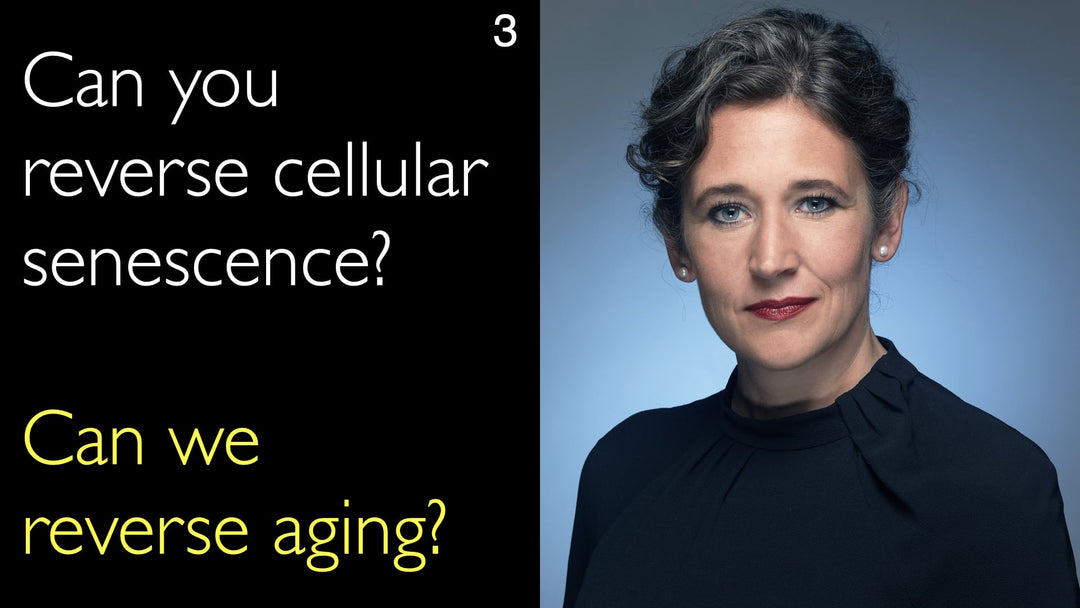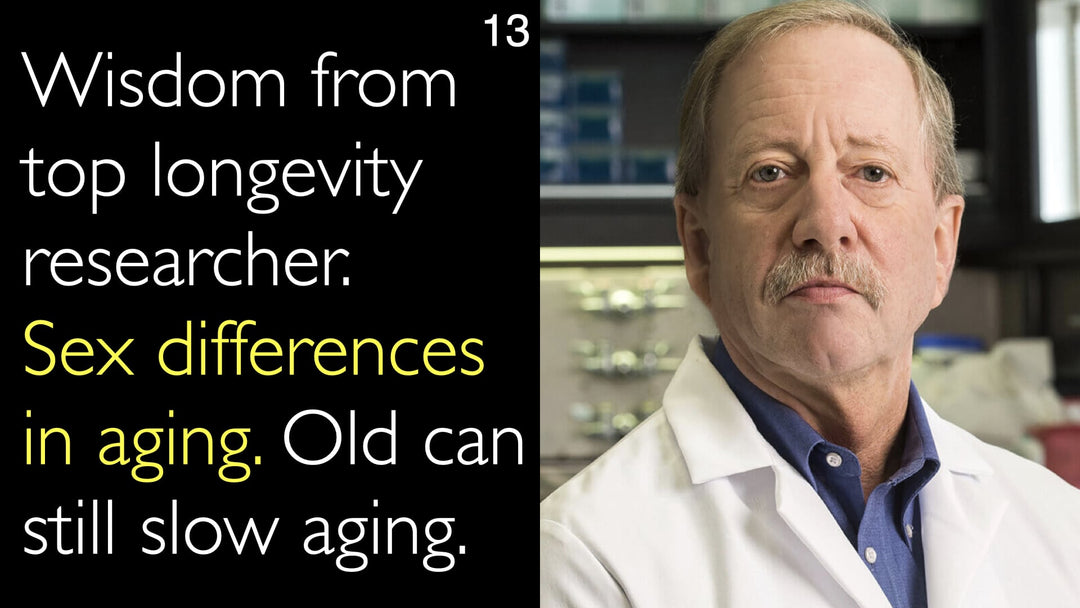Dr. Andrea Maier, eine führende Expertin für Alterung und zelluläre Seneszenz, erklärt, wie sich seneszente Zellen im Laufe des Lebens ansammeln. Diese Zellen teilen sich nicht mehr und setzen entzündungsfördernde Botenstoffe frei, was umliegendes Gewebe schädigt. Sie stehen im Zusammenhang mit altersbedingten Erkrankungen wie COPD und Herz-Kreislauf-Erkrankungen. Dr. Maier erörtert neuere Forschungsergebnisse zu senolytischen Medikamenten, die seneszente Zellen durch Apoptose gezielt entfernen können. Erste Studien an Tiermodellen deuten darauf hin, dass Senolytika sowohl die Gesundheit als auch die Lebensdauer verbessern können. Derzeit laufen klinische Studien am Menschen, um diese vielversprechenden Effekte zu bestätigen.
Umkehr der zellulären Seneszenz: Neue Perspektiven für die Behandlung altersbedingter Erkrankungen
Springe zu Abschnitt
- Seneszenz und der Alterungsprozess
- Der direkte Zusammenhang mit altersbedingten Erkrankungen
- Der entzündliche Einfluss seneszenter Zellen
- Senolytische Therapie: Beseitigung geschädigter Zellen
- Zukünftige Forschung und Humanstudien
- Vollständiges Transkript
Seneszenz und der Alterungsprozess
Zelluläre Seneszenz ist ein zentrales Merkmal des biologischen Alterns. Dr. Andrea Maier, MD, beschreibt sie als einen Zustand, in dem Zellen ihre Teilungsfähigkeit verlieren. Diese nicht mehr teilungsfähigen Zellen werden jedoch nicht ausgeschieden, sondern sammeln sich ab etwa dem 30. Lebensjahr im Körper an. Dr. Anton Titov, MD, erörtert dieses Phänomen im Interview. Mit zunehmendem Alter steigt die Anzahl dieser dysfunktionalen Zellen signifikant. So weist ein 80-jähriger Körper deutlich mehr seneszente Zellen auf als ein 30- oder 40-jähriger.
Der direkte Zusammenhang mit altersbedingten Erkrankungen
Die Ansammlung seneszenter Zellen ist keineswegs harmlos. Laut Dr. Andrea Maier, MD, sind diese Zellen direkt gesundheitsschädlich. Forschungsergebnisse belegen eine starke Korrelation zwischen einer hohen Belastung mit seneszenten Zellen und dem Auftreten spezifischer altersbedingter Erkrankungen. Vergleiche zwischen Personen gleichen Alters zeigen: Bei Erkrankungen wie COPD, kardiovaskulären Leiden oder Nierenfunktionsstörungen finden sich in den betroffenen Organen deutlich mehr seneszente Zellen. Dies deutet darauf hin, dass seneszente Zellen nicht nur ein Begleitphänomen des Alterns sind, sondern möglicherweise eine ursächliche Rolle bei der Krankheitsentstehung spielen.
Der entzündliche Einfluss seneszenter Zellen
Seneszente Zellen schädigen das Gewebe durch den sogenannten seneszenzassoziierten sekretorischen Phänotyp (SASP). Wie Dr. Andrea Maier, MD, erläutert, setzen diese Zellen eine Flut entzündlicher Zytokine frei – eine Art Notsignal an benachbarte Zellen. Die daraus resultierende lokale Entzündung und die unkontrollierte Stimulation von Zellteilungen schaffen ein toxisches Mikromilieu. Diese chronische, niedriggradige Entzündung gilt als Treiber von Erkrankungen wie Atherosklerose. Zugleich erhöht die erzwungene Replikation benachbarter Zellen das Risiko für Krebsneubildungen.
Senolytische Therapie: Beseitigung geschädigter Zellen
Der naheliegende nächste Schritt ist die gezielte Entfernung dieser schädlichen Zellen. Dr. Andrea Maier, MD, stellt eine vielversprechende neue Wirkstoffklasse vor: die Senolytika. Diese Substanzen sind darauf ausgelegt, spezifisch seneszente Zellen anzugreifen und sie in den programmierten Zelltod (Apoptose) zu treiben. Nach dem Absterben der Zellen beseitigt das Immunsystem die Überreste. Zurück bleibt ein gesünderes Gewebe, frei von den schädlichen Signalen, die Krankheitsprozesse vorantreiben.
Zukünftige Forschung und Humanstudien
Das Potenzial der senolytischen Therapie ist enorm. Dr. Andrea Maier, MD, verweist auf vielversprechende Studien an Mäusen, bei denen Senolytika sowohl die Gesundheitspanne – also die Lebenszeit ohne Krankheit – als auch die Gesamtlebensdauer verlängerten. Im Gespräch mit Dr. Anton Titov, MD, betont sie, dass die Forschung nun in die Phase der Humanstudien eintritt. Wissenschaftler prüfen aktiv, ob Senolytika beim Menschen das biologische Alter senken und den Ausbruch altersbedingter Erkrankungen verzögern können. Dies würde einen Paradigmenwechsel bedeuten: von der Behandlung hin zur möglichen Prävention altersbedingter Leiden.
Vollständiges Transkript
Dr. Anton Titov, MD: Welche Rolle spielt die zelluläre Seneszenz bei menschlichen Erkrankungen und beim Altern? Und ist es möglich, sie umzukehren?
Dr. Andrea Maier, MD: Zelluläre Seneszenz ist tatsächlich eines der Kennzeichen des Alterns. Dabei handelt es sich um einen Zustand, in dem Zellen ihre Teilungsfähigkeit verlieren. Sie verbleiben im Körper, können sich aber nicht mehr normal replizieren.
Unsere Zellen sind grundsätzlich zur Teilung befähigt. Zahlreiche Studien – besonders bei Menschen ab 30 – zeigen, dass sich seneszente Zellen mit dem Alter ansammeln. Das heißt: Mit 60, 70 oder 80 Jahren weist der Körper mehr seneszente Zellen auf als mit 30 oder 40.
Je höher das chronologische Alter, desto mehr seneszente Zellen sind vorhanden. Und das ist problematisch. Sobald eine Zelle seneszent wird, beeinträchtigt sie ihre Umgebung negativ. Sie kann sich nicht mehr teilen und sendet Hilfesignale aus: Sie setzt entzündliche Zytokine frei, um ihre Nachbarzellen zu alarmieren – quasi ein Ruf nach Unterstützung.
Dadurch verändert sich das Mikromilieu. Benachbarte Gewebe werden in Mitleidenschaft gezogen: Es kommt zu Entzündungen und unerwünschten Zellteilungen. Gesunde Zellen werden zur Replikation angeregt, obwohl sie es nicht sollten.
Das erhöht das Risiko für Atherosklerose, die mit Entzündungen einhergeht, oder für Krebs, der durch unkontrollierte Zellvermehrung entsteht. Und das konnten wir nachweisen.
Nicht nur ältere Menschen haben mehr seneszente Zellen, sondern besonders solche mit altersbedingten Erkrankungen – etwa COPD, kardiovaskulären Leiden oder Nierenfunktionsstörungen. In den betroffenen Organen dieser Patienten fanden wir deutlich mehr seneszente Zellen als bei gleichaltrigen Gesunden.
Das legt nahe, dass seneszente Zellen nicht nur Begleiter, sondern mögliche Verursacher altersbedingter Erkrankungen sind. Daher stellt sich die Frage: Können wir sie entfernen?
Hier setzt ein neues Forschungsfeld an: die Senolytika. Diese Substanzen leiten in seneszenten Zellen die Apoptose ein – den programmierten Zelltod. Stirbt die Zelle, wird sie vom Immunsystem beseitigt. Zurück bleibt ein gesundes, klares Gewebe ohne die krankmachenden Signale.
Erste Humanstudien laufen bereits, um zu testen, ob Senolytika das biologische Alter senken können. Meine Forschungen zeigen, dass sich bei Mäusen sowohl die Gesundheitspanne als auch die Lebensdauer verlängern ließen – also die Zeit ohne Krankheit. Das weist auf ein Potenzial für mehr Lebensqualität und Langlebigkeit hin.







